Abstract
The purpose of this study was to determine the locus of interaction of angiotensin peptides with the sympathetic nervous system leading to alterations in jejunal sodium and water transport. At low physiological doses, angiotensin II (AII) stimulates jejunal sodium and water absorption, while at high doses peptide inhibits absorption and/or stimulates secretion. Both the stimulation of jejunal transport and the inhibition of absorption were expressed in adrenalectomized rats. However, the stimulation of jejunal water absorption was abolished and a potentiated inhibition of transport was expressed in peripherally sympathectomized rats (intact adrenal medulla) and in normal rats after administration of guanethadine, phentolamine, and prazosin. The angiotensin analog (Sar1 Leu8)-AII has low efficacy and is a potent competitive antagonist of the parent peptide in pressor and myotropic systems, but is a full agonist with even greater potency than AII in stimulating jejunal transport. The increased water transport in response to (Sar1 Leu8)-AII is not secondary to enhanced renal renin release, as the analog also stimulated jejunal transport in the presence of captopril and after bilateral nephrectomy. The stimulation of absorption in response to (Sar1 Leu8)-AII alone or together with AII was abolished by phentolamine. These data demonstrate that AII-increased intestinal absorption is secondary to the release of norepinephrine from nerve endings in the jejunum and that AII inhibition of absorption is not mediated by the sympathetic nervous system. The analog (Sar1 Leu8)-AII is a full agonist in the stimulation of jejunal transport (increased norepinephrine release), but antagonizes the inhibitory response to high doses of AII. Angiotensin peptides are potent modulators of intestinal sodium and water absorption.
Full text
PDF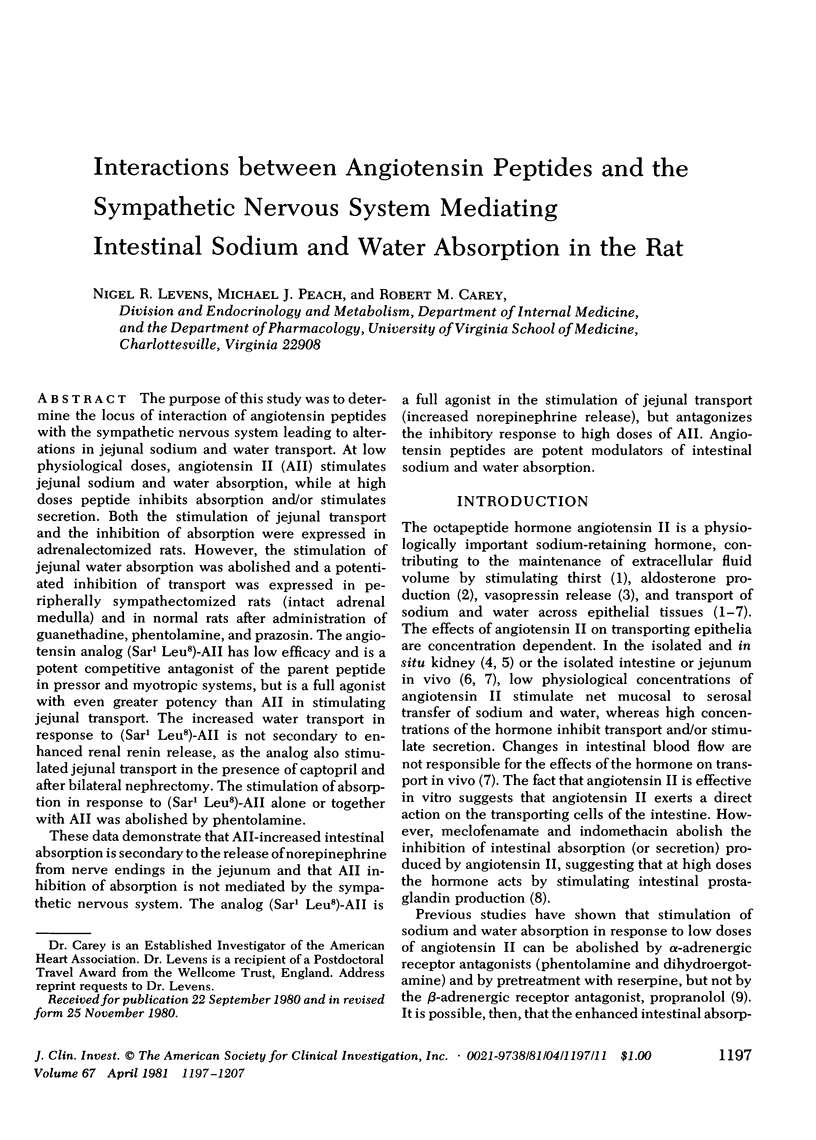
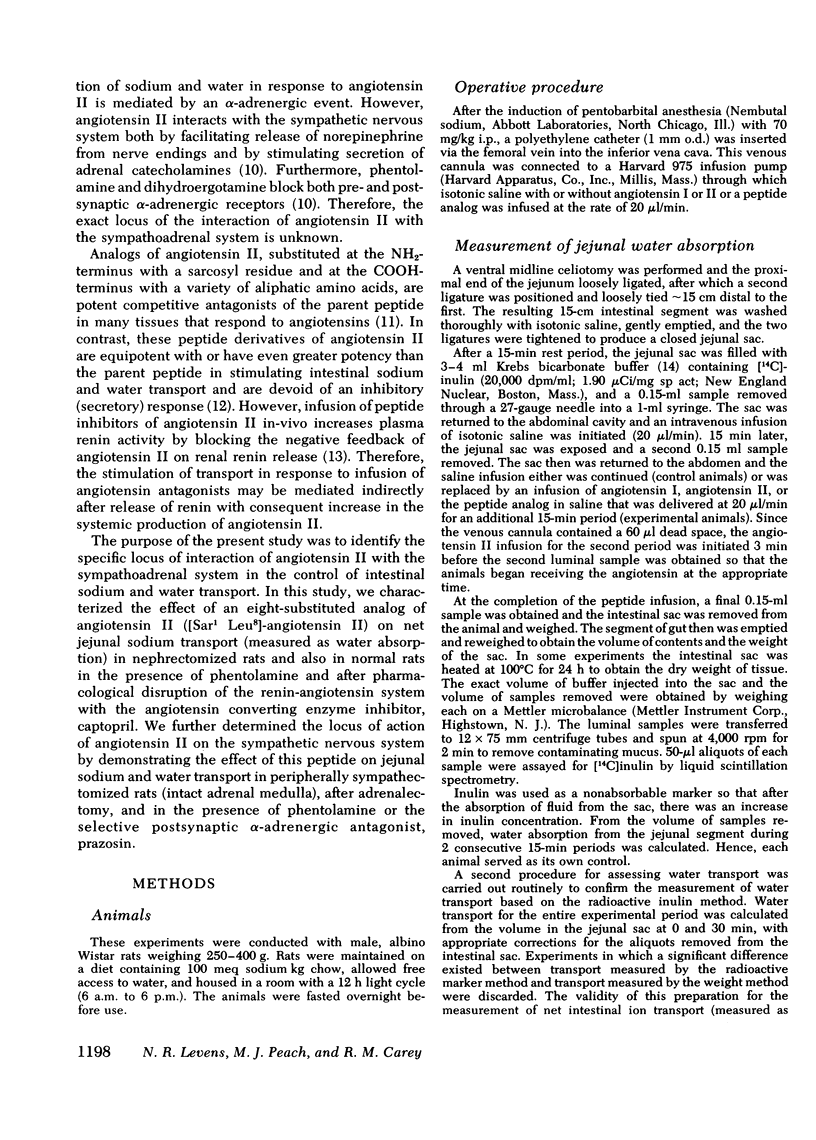
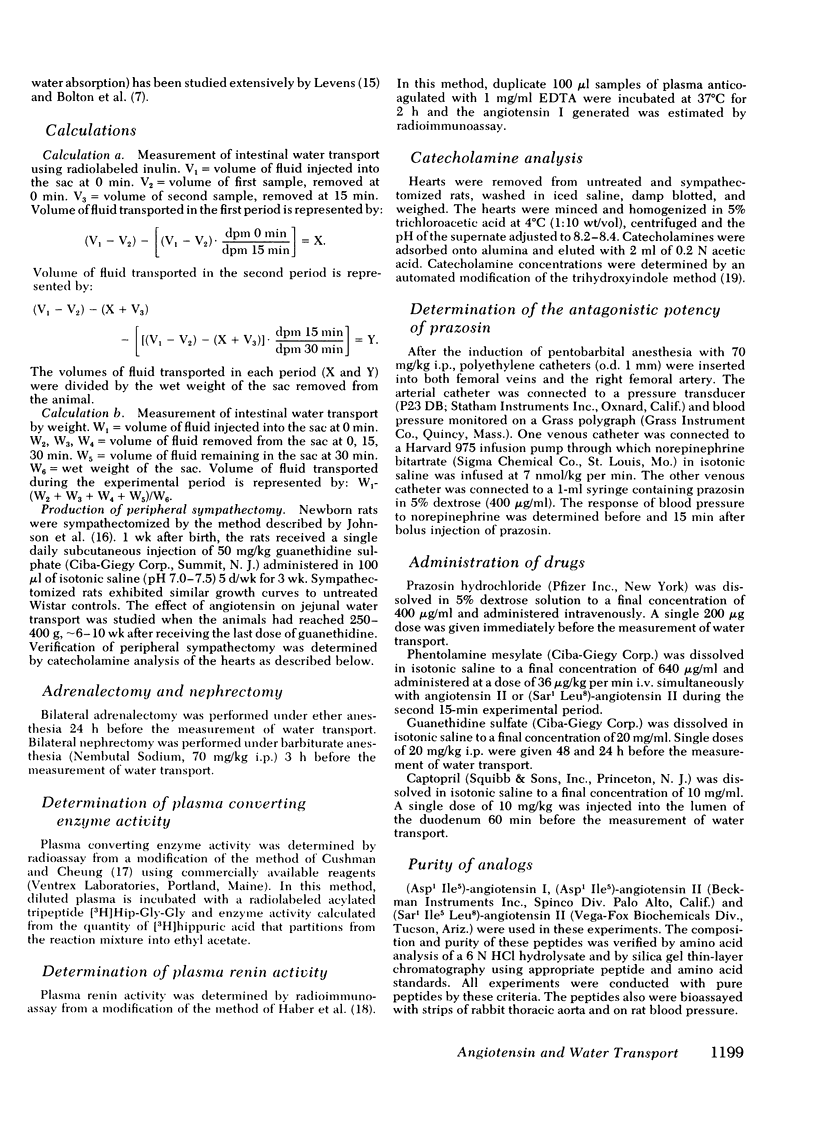
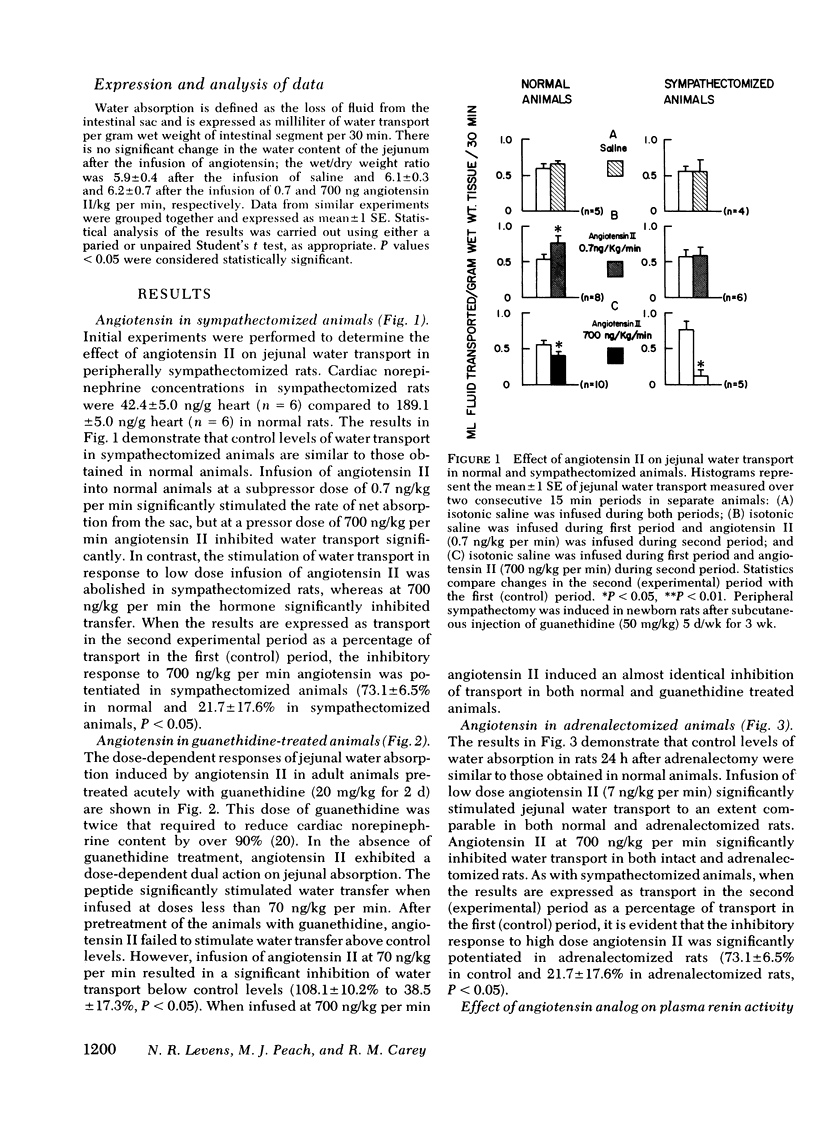
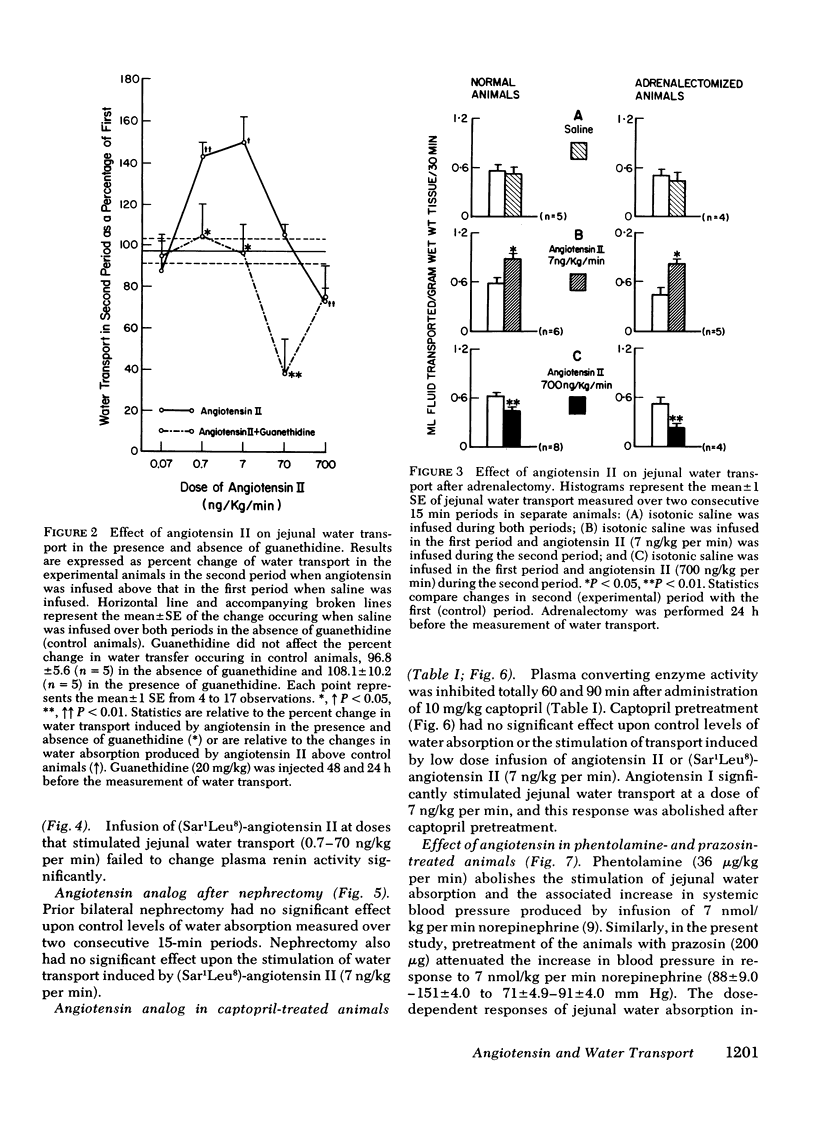
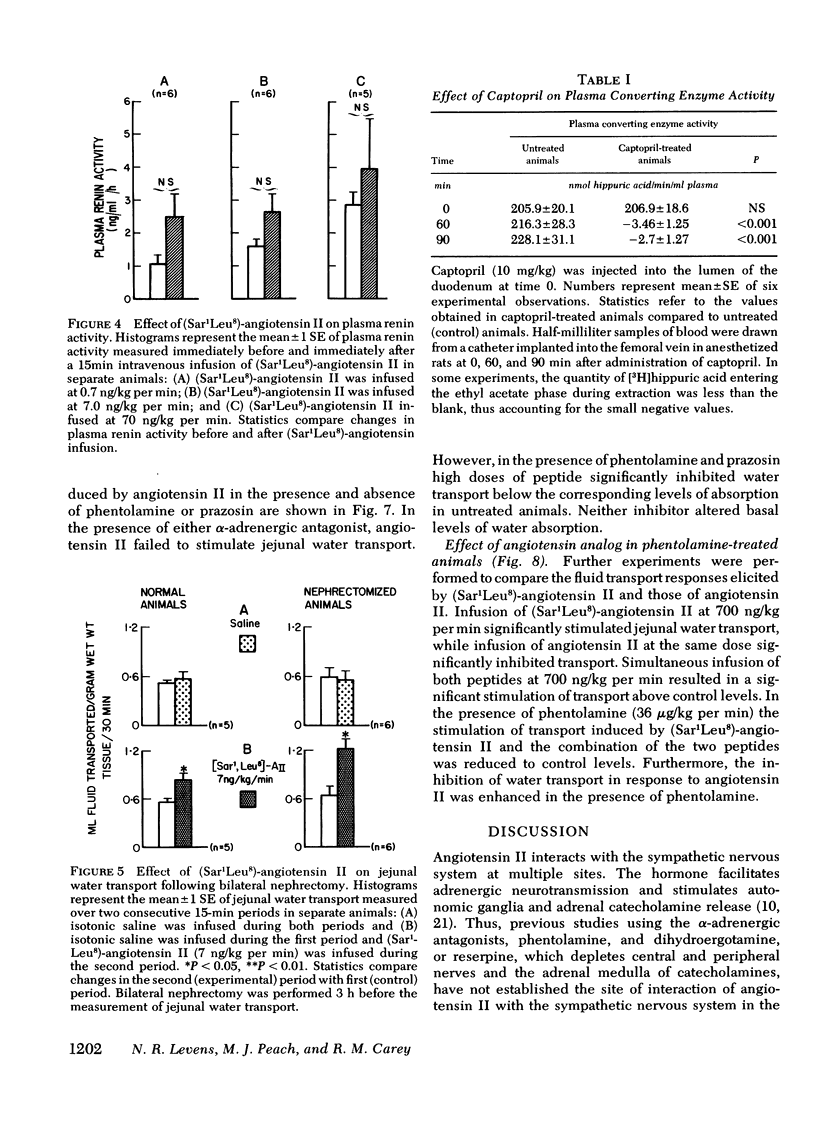
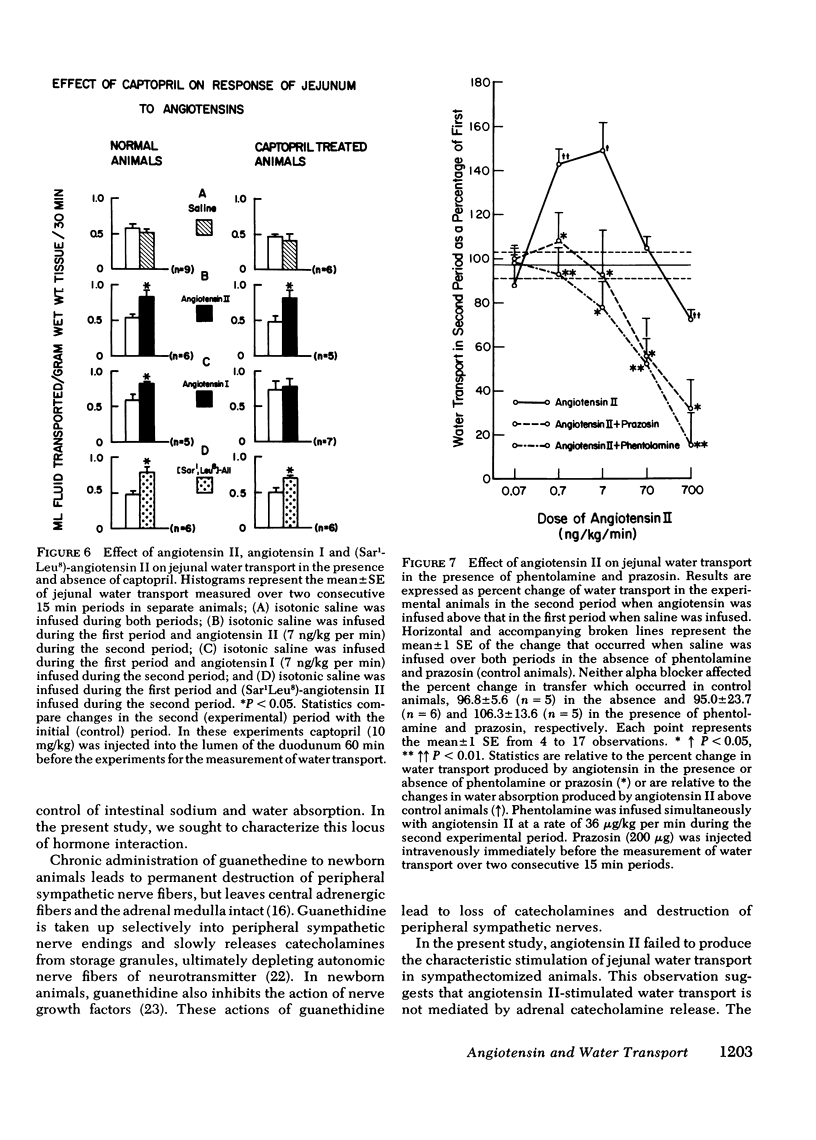
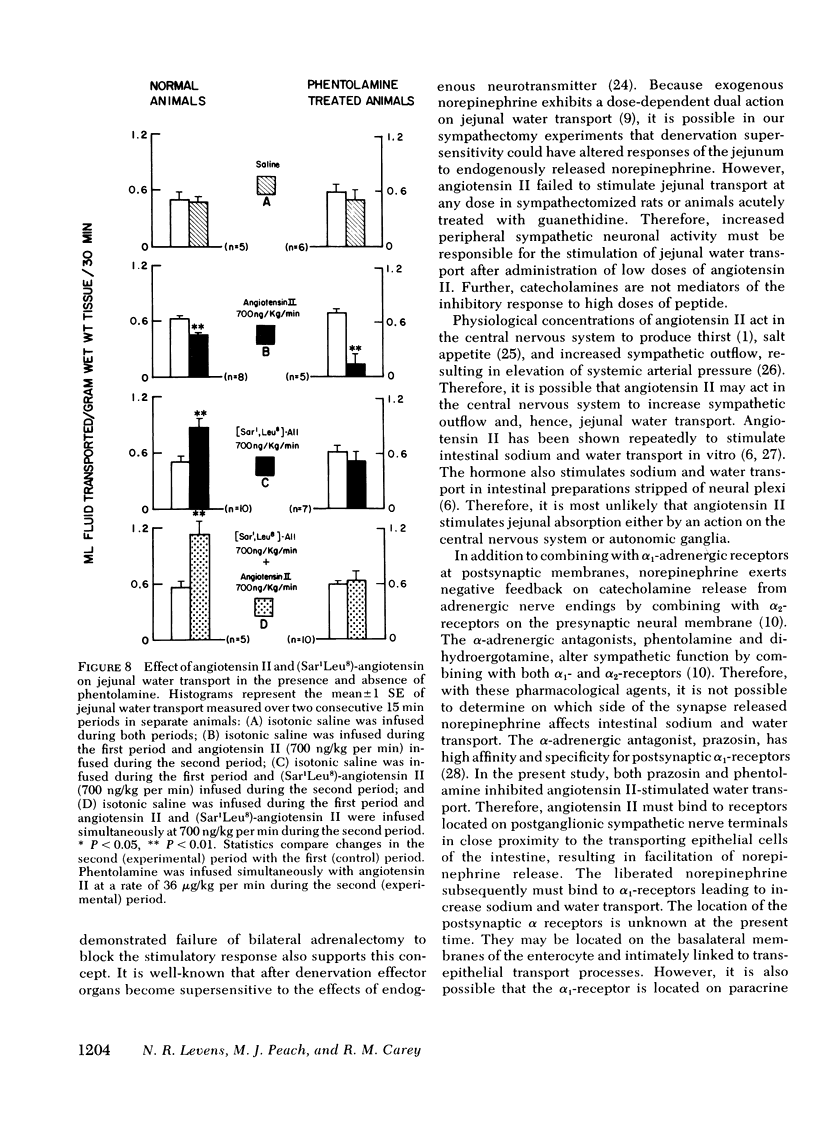
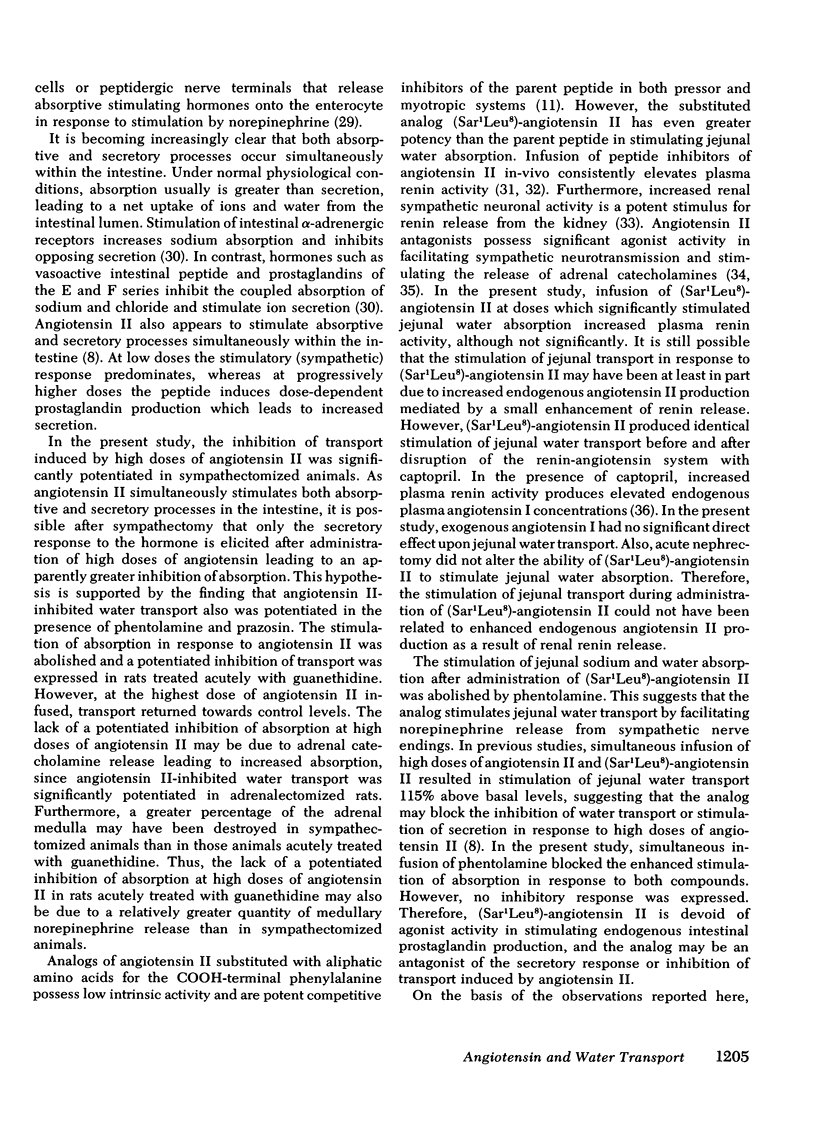
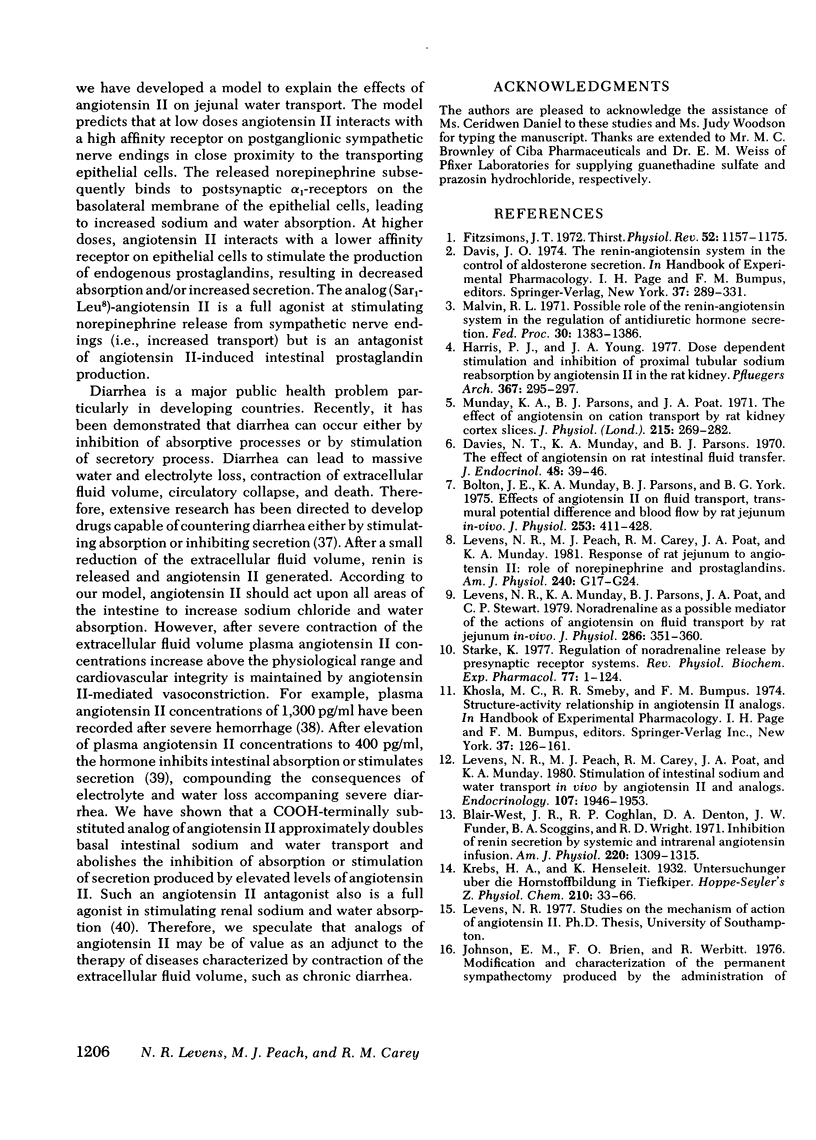
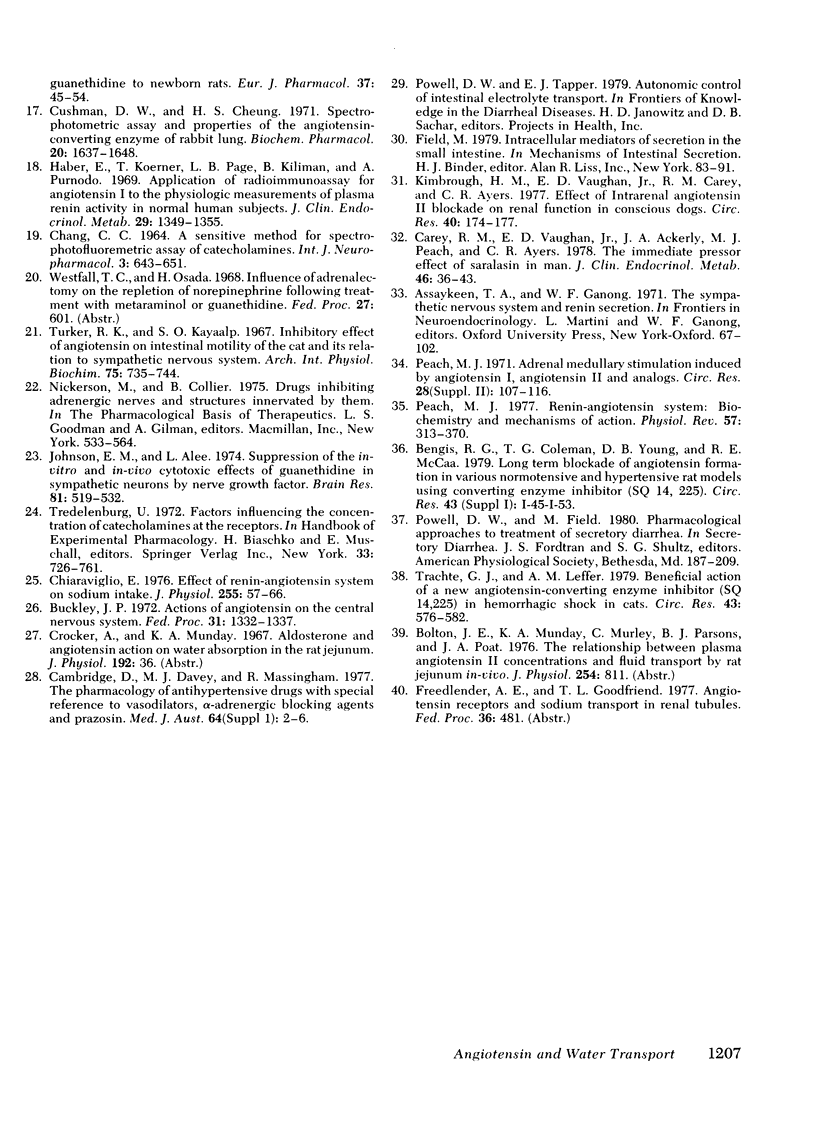
Selected References
These references are in PubMed. This may not be the complete list of references from this article.
- Blair-West J. R., Coghlan J. P., Denton D. A., Funder J. W., Scoggins B. A., Wright R. D. Inhibition of renin secretion by systemic and intrarenal angiotensin infusion. Am J Physiol. 1971 May;220(5):1309–1315. doi: 10.1152/ajplegacy.1971.220.5.1309. [DOI] [PubMed] [Google Scholar]
- Bolton J. E., Munday K. A., Parsons B. J., York B. G. Effects of angiotensin II on fluid transport, transmural potential difference and blood flow by rat jejunum in vivo. J Physiol. 1975 Dec;253(2):411–428. doi: 10.1113/jphysiol.1975.sp011197. [DOI] [PMC free article] [PubMed] [Google Scholar]
- Buckley J. P. Actions of angiotensin on the central nervous system. Fed Proc. 1972 Jul-Aug;31(4):1332–1337. [PubMed] [Google Scholar]
- CHANG C. C. A SENSITIVE METHOD FOR SPECTROPHOTOFLUOROMETRIC ASSAY OF CATECHOLAMINES. Int J Neuropharmacol. 1964 Dec;3:643–649. doi: 10.1016/0028-3908(64)90089-9. [DOI] [PubMed] [Google Scholar]
- Cambridge D., Davey M. J., Massingham R. The pharmacology of antihypertensive drugs with special reference to vasodilators, alpha-adrenergic blocking agents and prazosin. Med J Aust. 1977 Aug 20;2(1 Suppl):2–6. doi: 10.5694/j.1326-5377.1977.tb107750.x. [DOI] [PubMed] [Google Scholar]
- Carey R. M., Vaughan E. D., Jr, Ackerly J. A., Peach M. J., Ayers C. R. The immediate pressor effect of saralasin in man. J Clin Endocrinol Metab. 1978 Jan;46(1):36–43. doi: 10.1210/jcem-46-1-36. [DOI] [PubMed] [Google Scholar]
- Chiaraviglio E. Effect of renin-angiotensin system on sodium intake. J Physiol. 1976 Feb;255(1):57–66. doi: 10.1113/jphysiol.1976.sp011269. [DOI] [PMC free article] [PubMed] [Google Scholar]
- Cushman D. W., Cheung H. S. Spectrophotometric assay and properties of the angiotensin-converting enzyme of rabbit lung. Biochem Pharmacol. 1971 Jul;20(7):1637–1648. doi: 10.1016/0006-2952(71)90292-9. [DOI] [PubMed] [Google Scholar]
- Davies N. T., Munday K. A., Parsons B. J. The effect of angiotensin on rat intestinal fluid transfer. J Endocrinol. 1970 Sep;48(1):39–46. doi: 10.1677/joe.0.0480039. [DOI] [PubMed] [Google Scholar]
- Haber E., Koerner T., Page L. B., Kliman B., Purnode A. Application of a radioimmunoassay for angiotensin I to the physiologic measurements of plasma renin activity in normal human subjects. J Clin Endocrinol Metab. 1969 Oct;29(10):1349–1355. doi: 10.1210/jcem-29-10-1349. [DOI] [PubMed] [Google Scholar]
- Harris P. J., Young J. A. Dose-dependent stimulation and inhibition of proximal tubular sodium reabsorption by angiotensin II in the rat kidney. Pflugers Arch. 1977 Jan 17;367(3):295–297. doi: 10.1007/BF00581370. [DOI] [PubMed] [Google Scholar]
- Johnson E. M., Jr, Aloe L. Suppression of the in vitro and in vivo cytotoxic effects of guanethidine in sympathetic neurons by nerve growth factor. Brain Res. 1974 Dec 13;81(3):519–532. doi: 10.1016/0006-8993(74)90848-8. [DOI] [PubMed] [Google Scholar]
- Johnson E. M., Jr, O'Brien F., Werbitt R. Modification and characterization of the permanent sympathectomy produced by the administration of guanethidine to newborn rats. Eur J Pharmacol. 1976 May;37(1):45–54. doi: 10.1016/0014-2999(76)90006-6. [DOI] [PubMed] [Google Scholar]
- Kimbrough H. M., Jr, Vaughan E. D., Jr, Carey R. M., Ayers C. R. Effect of intrarenal angiotensin II blockade on renal function in conscious dogs. Circ Res. 1977 Feb;40(2):174–178. doi: 10.1161/01.res.40.2.174. [DOI] [PubMed] [Google Scholar]
- Levens N. R., Munday K. A., Parsons B. J., Poat J. A., Stewart C. P. Noradrenaline as a possible mediator of the actions of angiotensin on fluid transport by rat jejunum in vivo. J Physiol. 1979 Jan;286:351–360. doi: 10.1113/jphysiol.1979.sp012624. [DOI] [PMC free article] [PubMed] [Google Scholar]
- Levens N. R., Peach M. J., Carey R. M., Poat J. A., Munday K. A. Response of rat jejunum to angiotensin II: role of norepinephrine and prostaglandins. Am J Physiol. 1981 Jan;240(1):G17–G24. doi: 10.1152/ajpgi.1981.240.1.G17. [DOI] [PubMed] [Google Scholar]
- Levens N. R., Peach M. J., Carey R. M., Poat J. A., Munday K. A. Stimulation of intestinal sodium and water transport in vivo by angiotensin II and analogs. Endocrinology. 1980 Dec;107(6):1946–1953. doi: 10.1210/endo-107-6-1946. [DOI] [PubMed] [Google Scholar]
- Malvin R. L. Possible role of the renin-angiotensin system in the regulation of antidiuretic hormone secretion. Fed Proc. 1971 Jul-Aug;30(4):1383–1386. [PubMed] [Google Scholar]
- Munday K. A., Parsons B. J., Poat J. A. The effect of angiotensin on cation transport by rat kidney cortex slices. J Physiol. 1971 May;215(1):269–282. doi: 10.1113/jphysiol.1971.sp009468. [DOI] [PMC free article] [PubMed] [Google Scholar]
- Peach M. J. Adrenal medullary stimulation induced by angiotensin I, angiotensin II, and analogues. Circ Res. 1971 May;28(5 Suppl):107–117. doi: 10.1161/01.res.28.5.ii-107. [DOI] [PubMed] [Google Scholar]
- Peach M. J. Renin-angiotensin system: biochemistry and mechanisms of action. Physiol Rev. 1977 Apr;57(2):313–370. doi: 10.1152/physrev.1977.57.2.313. [DOI] [PubMed] [Google Scholar]
- Starke K. Regulation of noradrenaline release by presynaptic receptor systems. Rev Physiol Biochem Pharmacol. 1977;77:1–124. doi: 10.1007/BFb0050157. [DOI] [PubMed] [Google Scholar]
- Trachte G. J., Lefer A. M. Beneficial action of new angiotensin-converting enzyme inhibitor (SQ 14,225) in hemorrhagic shock in cats. Circ Res. 1978 Oct;43(4):576–582. doi: 10.1161/01.res.43.4.576. [DOI] [PubMed] [Google Scholar]
- Türker R. K., Kayaalp S. O. Inhibitory effect of angiotensin on the intestinal motility of the cat and its relation to sympathetic nervous system. Arch Int Physiol Biochim. 1967 Dec;75(5):735–744. doi: 10.3109/13813456709084930. [DOI] [PubMed] [Google Scholar]


